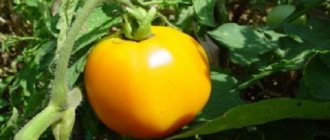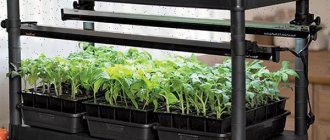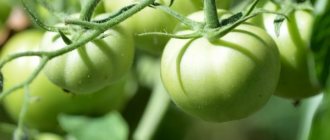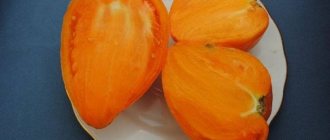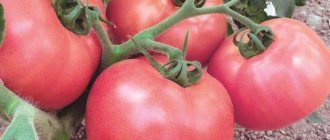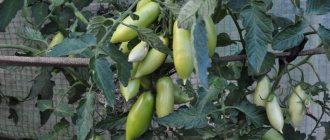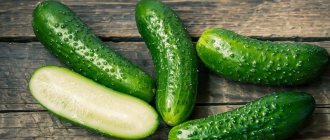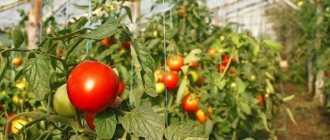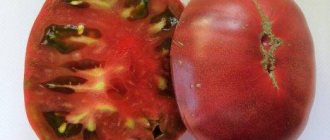Not everyone can find a fern flower on a festive night. But any farmer who has planted such an unusual variety will be able to enjoy Ivan Kupala tomatoes.
| Height | Landing location | Ripening time | Fruit color | Fruit size | Origin | Fruit shape |
| Medium height | Greenhouse, Open ground | Mid-season | Pink | Average | Variety | Pear-shaped |
Characteristics and description of the variety
The originator of the variety is agro.
The bush is indeterminate, 1.5-1.6 m high, heavily leafy. The leaves are slightly elongated, with smooth edges. The variety is mid-season, carpal. One brush bears up to 7 fruits.
Productivity is average. 2-3 kg of vegetables are harvested from 1 bush, provided that 3-4 seedlings are planted per 1 square meter. m. Endowed with innate immunity to the main diseases of the nightshade family.
The culture requires obligatory pinching and tying up of tall bushes.
Reference. Stepchildren are lateral processes on the stem growing from the axil of the leaf. Stepsoning a plant is called removing the stepsons. Pruning is carried out so that nutrients are spent on the formation and ripening of high-quality fruits, and not on the growth of unnecessary shoots.
Ivan Kupala is recommended for cultivation in open ground and in greenhouse conditions.
The fruits have a shape uncharacteristic for a tomato, externally they resemble a pear , the average weight of one is 150-200 g. The color is red-raspberry, the taste is excellent, sweet, without a sense of sourness. The skin is thin but dense, so the fruits do not crack. The pulp is juicy and fleshy.
The purpose of tomatoes is universal: they are suitable for pickling, marinades and canning. They are also used for processing to make tomato products: paste, ketchup, juice. But the most important purpose is fresh consumption. Tomatoes are ideal for summer salads, vegetable dishes, appetizers and baked meats.
Despite the dense peel, vegetables cannot withstand long-distance transportation , although they can be stored for a long time.
The photo shows Ivan Kupala tomatoes.
Diseases and pests
“Russian domes” do not have strong immunity, so they require constant attention from the gardener. If any painful signs are detected, treatment should begin immediately: the affected parts of the plants should be eliminated, and healthy plants should be treated with appropriate preparations.
To reduce the likelihood of diseases occurring, preventive measures should be taken:
- Ventilate the greenhouse daily and change the top layer of soil annually;
- Do not plant tomatoes in the ground from under any nightshade crops;
- Avoid dense plantings;
- Do not over-water or over-dry the bed;
- Once a month, spray the plantings with garlic infusion.
How to grow seedlings
Sowing of seeds begins 60-65 days before planting seedlings in the ground. First, the seeds are checked for germination in a saline solution. To do this, dilute half a teaspoon of salt in 1 glass of water and dip the grains into the solution for 10 minutes. Those that have floated to the surface are not suitable for sowing.
Reference. Tomato seeds remain viable for 5 years. After this period, germination and fruiting are much slower.
Then the seeds are disinfected in a weak solution of potassium permanganate or in a 2% solution of hydrogen peroxide. The grains are placed in gauze and placed in a disinfecting solution. Leave in potassium permanganate for 20-30 minutes, in peroxide for 8 minutes.
Only germinated seeds are sown in the ground. To do this, they are placed between two pieces of gauze, slightly moistened and left in a warm and dark place at a temperature of 22-25°C. Periodically moisten the gauze to prevent it from drying out. The grains sprout on days 5-7. After germination, they are immediately transferred to a illuminated place - on a windowsill or under artificial lighting lamps.
The soil is prepared from garden soil, humus and peat and the planting containers are tightly filled with it. Sprouted grains are sown to a depth of 1 cm and covered with a thin layer of earth on top. The containers are moistened with a spray bottle and left in a warm room at a temperature of at least 22°C.
You can plant in a common wooden box or in individual plastic and peat cups. Peat cups have the best indicator of seed germination.
A few days after sowing, the first shoots appear. During this period, the temperature is reduced to 18°C.
Water the soil as the top layer dries out, moderately, without flooding the young shoots, with warm, settled water from a shallow watering can. After watering, the soil is loosened with a wooden stick, superficially, so as not to damage the roots.
Daylight hours for seedlings should be at least 16 hours. If natural light is not enough, add phytolamps.
When 2 true leaves appear, the seedlings are picked and placed in separate containers. If the seeds are sown in individual containers, picking is not carried out.
A week before planting in open ground, seedlings begin to adapt to outdoor conditions using the hardening method. To do this, they are taken out into the open air for 1-2 hours, gradually increasing the interval of stay on the street to 14 hours. At the same time, the night temperature of the room where the seedlings are brought overnight is reduced to 12-14°C.
Planting a tomato
It is recommended to start preparing seeds a couple of months before planting. For tomato seedlings, you can use standard soil, which is well moistened in advance. The sprouts will hatch much faster if the soil is previously kept warm for several days. To eliminate the possibility of unhealthy shoots, you need to find a large, capacious container.
Gentle watering should be done with a garden sprayer several times. The Ivan Kupala variety loves warmth, so it is necessary to maintain room temperature. Lamps can be used for this.
You will also need plastic film to cover the seedlings. Tightness will create a greenhouse effect. 7 days before planting, it is necessary to harden the sprouts at a low temperature (8 degrees). Ventilation must be excluded. A few days before planting in the soil, it is better not to water the plants so that they are not too sensitive to transplanting and carrying. The earth should be warm (at least 12 degrees).
Fruit ripening lasts 110-115 days. This variety is considered mid-season. If you pick off the leaves and let the sun shine directly on the tomatoes, the plant will ripen faster.
tomato Izobilny - description and characteristics of the variety
How to grow tomatoes
After 2 months, the seedlings are ready for planting in open ground. By this time, young bushes reach 30-35 cm in height and have 12-14 true leaves. An important factor when replanting is soil temperature. It should not be lower than 12°C. Otherwise, soil that is not heated to the required temperature will slow down the growth and development of the crop.
Planting pattern: 50 cm – distance between seedlings, 50 cm – between rows. For 1 sq. m place no more than 4 seedlings.
The wells are prepared in advance by adding 1 tablespoon of ash and 0.5 teaspoon of superphosphate to them. The depth of the hole is 15 cm.
After transplanting, the soil is moistened, loosened and hilled, and within 1 week the young bushes get used to the new place. To retain moisture, the beds are mulched with straw or weeds, which later, when rotting, provide the young plants with the necessary nutrients.
In addition, mulching the beds prevents the penetration of pests. A week later, regular moderate watering is established. Water strictly at the root, with warm, settled water, no more than 2 times a week. On hot, dry days, the number of waterings is increased to 4. It is important to monitor the condition of the soil and not to over-wet the soil. With high humidity, fungal spores can quickly develop, which will lead to plant disease.
The first feeding is carried out 2 weeks after transplantation. Fertilize with organic matter, for example, chicken droppings, humus or mineral fertilizers. The main thing is to dilute the organic matter well with water to avoid burns to the root system. The optimal ratio is 1:15.
Reference. When using fresh manure as a top dressing, the taste of tomatoes becomes bitter.
The second feeding is carried out during the appearance of flowers, and the third - during fruit set.
Another important stage in crop care is stepsoning. If you do not remove excess shoots, the growth of green mass will lead to the fact that the fruits will not be able to receive the necessary nutrients for further development. Shoots are removed when their length is 4-8 cm. At this stage of growth, the plant experiences the least stress. After removing the stepsons, the bushes are treated with a weak solution of potassium permanganate to reduce the risk of infection.
Reference. The pinching procedure is carried out in the morning so that by the evening all the wounds have time to heal.
The plant is formed into 2 stems. This method leads to the best fruiting rate.
If you are tall, a garter is required. Despite the strong stem, the tall bush will not be able to withstand the fruiting clusters and will break from the weight of the ripe fruits. They tie it up immediately when transplanting seedlings into the ground. A wooden support or metal rods are installed next to each bush and the stem is fixed for its proper further formation. As the branches grow and develop, they are also fixed to the support.
Diseases and pests
The culture has proven itself to be resistant to major diseases of the nightshade family and pest attacks. However, the plant can be affected by late blight and powdery mildew.
These are fungal diseases, which means that high humidity and air temperature are necessary for their spread. Monitoring the moisture content of the beds is a necessary preventive measure, as is the removal of lower leaves that can rot, thereby helping the development of fungal spores.
When affected by late blight, the bushes are treated with systemic fungicides, for example, Fitosporin.
This fungicide is also used to combat powdery mildew.
Mustard powder, which is sprayed on the crop, protects against the Colorado potato beetle, whitefly, aphids and slugs. Mustard bushes planted between tomatoes also repel these pests. You can also spray with a solution of vinegar, the smell of which is smelled by parasitic insects from afar and avoided.
A soap solution used to treat the affected stems helps against aphids. To prepare the solution, dissolve 1 piece of laundry soap in 2 liters of water.
Diseases and pests
The variety has a fairly high level of resistance to diseases and parasites. But despite this, the plant can be affected by fungal diseases such as late blight, powdery mildew and others. To avoid this problem, when watering, do not allow water to get on the leaves. Watering must be done at the root of the plant. If, after all, “Ivan Kupala” is affected by a fungus, you should use fungicides.
To avoid the appearance of parasites, such as the Colorado potato beetle, whitefly, aphids, naked slugs, you need to use mustard powder, or plant one mustard stalk between the bushes. Coloradas cannot tolerate this taste and smell and avoid the plant. You can also use a vinegar solution. Such a means “cuts down the enemy”, destroying him from the inside.
If aphids or whiteflies appear, you can use a soap solution. 1 piece of laundry soap is dissolved in 1-2 liters of water and the affected areas are sprayed with it.
The nuances of growing in a greenhouse and in open ground
The variety is recommended for cultivation in open ground and in protected structures. In the southern regions, where summers are warm and long, tomatoes are grown in open beds. In cold regions with short and cool summers, it is recommended to cover with film.
Greenhouse bushes grow higher, so the crown of the plant is pinched to indicate the growth point.
Closed structures require systematic ventilation. Constant high temperature and humidity contribute to the rapid spread of fungal spores, which leads to disease. A regular supply of fresh air destroys the pathogenic environment of infections and some insect pests living in greenhouse conditions.
Recommendations for cultivation
Tomatoes of most varieties prefer the seedling planting method. Ivan Kupala tomatoes begin to be prepared two months before planting day. Strong seedlings are obtained by following simple rules of agricultural technology:
- It is advisable to prepare separate containers for seedlings, filling them with universal soil for nightshade plants.
- Pre-water the soil.
- Plant seeds 1.5–2 centimeters into the ground.
- Subsequent irrigation of the planting with a spray bottle.
- Compliance with temperature conditions, from 20 degrees.
- Creating a greenhouse effect by covering the crops with film.
- Move the first shoots to a well-lit place; daylight hours should not be less than 16 hours.
- Hardening off the sprouts a week before planting.
IMPORTANT! When planting, it is not recommended to place more than 4 tomato bushes per square meter of land.
Gardeners do not advise placing seedlings too tightly. To get a good harvest, it is enough to follow simple rules of agricultural technology: watering with warm water, loosening and removing weeds from the soil, feeding and pest prevention, tying and timely pinching.
Harvesting and application
Harvesting begins in early August.
The ripening of fruits is not uniform, at different times, but picking ripe vegetables from tied branches is not difficult. The most important purpose of vegetables is to eat them fresh. They are ideal for summer salads, appetizers, hot and vegetable dishes (stews, purees). Vegetables are high in vitamins and are recommended to boost immunity. Suitable for dietary nutrition.
Small tomatoes are used for canning and pickles, while larger fruits are good in marinades. Vegetables retain their taste in processed tomato products (ketchup, juice, paste, sauces, adjika).
The optimal transportation period is no more than 10 days. This tomato variety does not retain its taste characteristics and presentation during long-term transportation, although it can be stored for a long time.
Caring for the Ivan Kupala tomato
Bush formation
It is very important to shape the tomato bush and remove all excess shoots. If this is not done, the green mass will grow in large quantities, and this will be detrimental to the development of tomatoes. In addition, the likelihood of various diseases increases.
There are no difficulties in forming a bush. It is important to do everything gradually.
It is imperative to perform operations with gloves. After processing each bush, wet your hands in a weak solution of potassium permanganate, this will protect the plants from infection.
It is necessary to remove only those stepsons that have reached 4-7 centimeters. If the length is less than 4 or more than 8, then the plants experience stress, respectively, immunity decreases and the likelihood of contracting infections increases.
All procedures must be carried out in the morning so that the wounds on the stumps can heal by the evening.
Regarding tying up the plant
This procedure must be carried out throughout the growth of tomatoes. If you do not tie up the bush, the plant may break under the weight of the fruit. In addition, a stem that reaches one and a half meters in height simply cannot stand on its own.
Stepsonning. What it is?
Shoots that are not fully developed are called stepsons. If they are not removed, the plant will gain green mass, accordingly, all the forces of the plant will be directed in this direction, and not on setting new fruits, the leaves grow thicker and more abundantly, the smaller the tomatoes become, and it may be that the fruits will not form at all. In order to balance the development of the plant, pinching is carried out. It consists in removing unnecessary shoots before they become denser.
The first stepsons are already observed on seedlings. This is the only time when removing shoots 1 centimeter in size is permitted. Despite the fact that this is a very complex process, it greatly simplifies future stepsoning.
Watering and feeding
Tomatoes do not need frequent watering. It is enough to water seedlings once every three to four days, but adult plants need watering once a week. It is very important to monitor the condition of the soil; it is best to dig up the soil to a depth of about 10 centimeters every few days and look at its condition. It is easy to see if the soil needs moisture. How to determine? You need to take a little earth in your hand and squeeze it. If a lump has formed, then the plant has enough water, but if the soil has crumbled, it needs to be watered.
Fertilizer
Complementary feeding should be provided at least 3 times per season. The first time two weeks after planting in the ground, the second time feeding during the appearance of buds. And the third - during fruit set. You can also add intermediate, but moderate ones. It is not advisable to carry out more than 5 feedings throughout the summer.
It is best to fertilize with organic fertilizers, such as chicken manure, humus (it is very important not to use fresh manure, as tomatoes then have a bitter taste). You can also alternate mineral and organic fertilizers. If you are used to using any biological products, there is nothing scary about it.
Advantages and disadvantages of the variety
In addition to its unusual appearance and ideal taste, the Ivan Kupala tomato has many other positive characteristics:
- ease of care;
- ability to settle down in any region;
- high resistance to major diseases;
- good fruiting rate;
- the ability to independently select seeds for the next planting;
- excellent taste of vegetables;
- unusual shape;
- contains a large amount of vitamins;
- suitable for dietary nutrition.
Some negative aspects of this type:
- Garter required;
- stepsoning required;
- does not tolerate long transportation.
Features of cultivation
Purchase and selection of seeds
Before you buy the first seeds you come across, pay attention to their packaging. It is important that the seeds are stored in a paper bag that should not have any defects. If you notice that the paper packaging has smudges, it means that the humidity has been increased; if there are burnt areas, it means the seeds were in direct sunlight. Also, in no case should there be any dents, cuts, or holes - all this indicates that the storage conditions were not met. Pay attention to the packaging expiration date.
Child hands putting tomato seeds into fertile soil in germination tray
Tomato seeds may be suitable for sowing for 5 years, but those that sit longer will take longer to germinate and bear fruit later, and fresher packages will give faster results.
In addition to the fact that you bought the seeds, they need to be selected. High-quality seed has a beige color, large size and significant weight. All the rest are empty and it is unlikely that anything can be grown from them. If you need to sort through a huge amount of seeds, you need to use an easier method. To do this, you need to dilute a spoonful of salt in one glass of water. Throw tomato seeds into this saline solution, mix well and leave for about 10 minutes. After this time, high-quality tomatoes will fall to the bottom, and those that remain on top must be carefully reconsidered again; it happens that the seeds dry out and remain floating on top. Those unsuitable for planting are thrown away, all the rest can be prepared for sowing.
Preparing for seedlings
Warming up the seed material is only used if, before sampling, it was stored in a cold room, such as a refrigerator/warehouse. They need to be warmed up a month and a half before sowing in the ground. The procedure is performed for a week, gradually increasing the temperature. Start at room temperature (16-18 degrees) ending at 80 degrees. At home it is easier to warm up using a battery. Seeds must be placed in fabric bags and not removed from the battery for several days.
Seed disinfection
Most diseases, or rather their viruses, live on the surface of seeds. To destroy them, the seeds must be disinfected. There are two methods of disinfection. For the first, you need to take (or make it yourself) a one percent solution of potassium permanganate. For the second, heat a two percent peroxide solution to 40 degrees. In both cases, the seeds must be wrapped in gauze and dipped into the prepared solution. In the first case, you need to wait 20-30 minutes, in the second case, no more than 8 minutes. Seeds are planted for seedlings 65 days before the intended planting in the ground.
Read also: Jellied pie with milk recipe
Germination
Before you sow the seeds, so that they sprout faster, they need to be grown. There is nothing complicated about germination. We place the pre-treated seeds between two pieces of gauze, and then moisten them with water, it is important that the gauze is not too wet. We place it all in a warm place, the temperature should be between 20-25 degrees. Periodically it is necessary to moisten the fabric, not allowing it to dry out. Within 5-7 days, small sprouts should hatch. As soon as this happens, we move the seeds to a lighted place. A window on the sunny side or a fluorescent lamp are perfect for this.
Then you can plant the seeds.
In a container tightly covered with soil, we bury the seeds about 1 centimeter, and cover with a thin layer of earth on top. Immediately after planting, it is necessary to spray the plants with warm water and place them in a lighted place. If everything was done correctly, after about a week the first loops will appear. Once this happens, the temperature drops to room temperature, around 18 degrees Celsius.
Landing in the ground
Tomatoes should only be planted when the plant has reached 35 centimeters in height and has approximately 10-15 true leaves. In addition, an important indicator is the soil temperature. Cold soil only stops the growth and development of the crop. The optimal temperature for planting is considered to be 10 degrees Celsius.
It is necessary to plant in pre-prepared holes, to the bottom of which one tablespoon of ash and half a teaspoon of superphosphate are added.
The stems of the seedlings must be buried down to the first leaf and always at an angle, this will make it possible to simplify pinching and tying in the future.
Farmer reviews
Most opinions indicate the excellent taste of ripe vegetables and simple agricultural technology. Many gardeners are interested in this crop precisely because of its unique external characteristics, since whole-fruit canned vegetables look very unusual.
Some opinions of summer residents:
Angelina, Kislovodsk: “I really liked the tomato. Pleasant taste, excellent pickling. They do not require any care; the harvest is enough for the whole family. Ideal for all lovers of excellent tomatoes."
Adam, Ryazan region: “I was struck by the unusual shape and color. From the bush, as stated, 2-3 kg of vegetables can be harvested, it is not demanding in care, and no diseases have affected it. I’ll definitely plant more.”
Gardeners' opinions
- Lenchik, 38 years old:
I liked the variety. And I want to share my experience. My advice is absolutely simple. The sprouts should not be placed close together or tightly. An excellent harvest is guaranteed to appear in the garden if you follow the basic instructions: loosen the soil, remove weeds, feed the soil with fertilizers, take preventive measures against parasites, tie them to pegs, and periodically water the seedlings. - Igor S., 48 years old:
Before buying the seeds, I read a lot about this variety. The reviews were very mixed. Some believe that the stated description is not true. However, many also say, for example, my neighbors in the country, that if the recommendations and rules are properly followed, the harvest will be pleasantly pleasing. At the same time, they plant seeds that they collected themselves. I took a chance and planted Ivan Kupala. Overall I was pleased with the harvest, but you need to grow it wisely.
tomato Impala - description and characteristics of the variety
